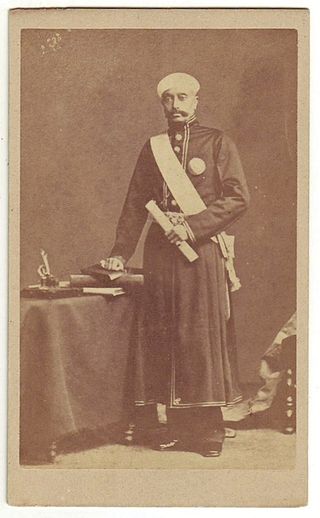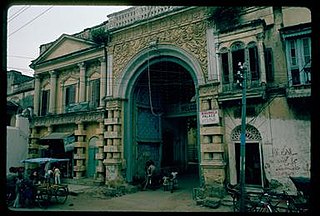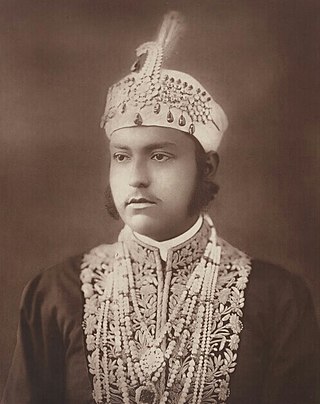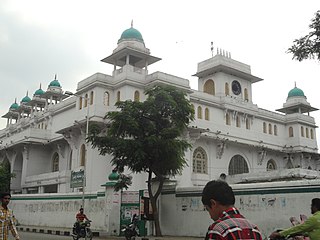
The Nizams were the rulers of Hyderabad from the 18th through to the 20th century. Nizam of Hyderabad was the title of the monarch of the Hyderabad State. Nizam, shortened from Nizam-ul-Mulk, meaning Administrator of the Realm, was the title inherited by Asaf Jah I. He was the former Naib (suzerain) of the Great Mughal in the Deccan, the premier courtier of Mughal India until 1724, the founding of an independent monarchy as the "Nizam of Hyderabad".

Asaf Jah VI, also known as Sir Mir Mahboob Ali Khan Siddiqi Bayafandi, was the 6th Nizam of Hyderabad. He ruled Hyderabad State, one of the princely states of India, between 1869 and 1911.

SirMirza Muhammad IsmailAmin-ul-Mulq was an Indian statesman and police officer who served as the Diwan of Mysore, Jaipur, and Hyderabad.

Paigah family is a noble family of Hyderabad State, The Three Great Paigah Amirs H.E Sir Asman Jah, H.E Sir Viqar-ul-Umra and H.E Sir Khursheed Jah who were the highest order of nobility under the Nizam of Hyderabad and held the honorary monarchal (standard) behind the Nizam. The family maintained their own court, individual palaces, and a standing army of about fourteen thousand infantry and cavalry troops.

Sir Mir Turab Ali Khan, Salar Jung I,, known simply as Salar Jung I, was an Indian nobleman who served as Prime Minister of Hyderabad State between 1853 until his death in 1883. He also served as regent for the sixth Nizam, Asaf Jah VI between 1869 and 1883.

The Salar Jung family was a noble Hyderabad family under the Nizams, who ruled from 1720 to 1948. They are credited with safeguarding rare artifacts and collections, which are now at Salar Jung Museum.

Malwala Palace was built in 1845 and is located in Hyderabad, telangana, India. Malwala Palace was located along the road leading towards east from Charminar. It was constructed in Mughal and Rajasthani style and in Hyderabadi courtyard style, was known for its richly carved. wooden pavilion. Other than Raja Bhagwandas Bagh Pavilion, Malwala Palace was the only other palace in Hyderabad having a wooden pavilion. Barring the grand gateway, the entire palace complex has been demolished in August 2000 and a shopping mall has been built in its place.

Paigah Tombs or Maqhbara Shams al-Umara, are the tombs belonging to the nobility of Paigah family, who were fierce loyalists of the Nizams, served as statespeople, philanthropists and generals under and alongside them. The Paigah tombs are among the major wonders of Hyderabad State which known for their architectural excellence as shown in their laid mosaic tiles and craftsmanship work. The Paigah's necropolis is located in a quiet neighbourhood 4 km southeast of Charminar Hyderabad, at Pisal banda suburb, down a small lane across from Owasi Hospital near Santosh Nagar. These tombs are made out of lime and mortar with beautiful inlaid marble carvings. These tombs are 200 years old which represent the final resting places of several generations of the Paigah Nobles.

Nawab Abul Quasim Owaisi, Mir Yousuf Ali Khan, Salar Jung III (1889–1949), commonly known as Salar Jung III, was a nobleman and art collector from Hyderabad Deccan. He served as Prime Minister of Hyderabad Deccan during the reign of the seventh Nizam, Mir Osman Ali Khan. In 1912, at the age of twenty-three, Salar Jung III succeeded Maharaja Sir Kishen Pershad as Prime Minister and served for two and a half years. He held the fourth-highest position among the Hyderabad Deccan nobility, below three members of the Paigah family.

Mir Laiq Ali Khan,Salar Jung II was a former Prime Minister of Hyderabad State (1884–1887). He belonged to the noble Salar Jung family. He is also known for authoring the Persian-language travelogue Vaqayeʿ-e Mosaferat.

The Veiled Rebecca or The Veiled Rebekah is a 19th century sculpture carved out of marble in Italian neoclassical style by the sculptor Giovanni Maria Benzoni.The sculpture is also referred as The Veiled Lady in several records. It depicts a biblical figure of Rebecca placed on a marble pedestal.

Mah Laqa Bai, born Chanda Bai, and sometimes referred to as Mah Laqa Chanda, was an Indian 18th century Urdu poet, tawaif and philanthropist based in Hyderabad. In 1824, she became the first female poet to have a diwan of her work, a compilation of Urdu Ghazals named Gulzar-e-Mahlaqa, published posthumously. She lived in a period when Dakhini was making its transition into the highly Persianized Urdu. Her literary contributions provide insight into such linguistic transformations in southern India.

The Old City of Hyderabad is a walled city of Hyderabad, Telangana, India, located on the banks of the Musi River built by Qutb Shahi sultan Muhammed Quli Qutb Shah in 1591 AD. There used to be a wall surrounding the Old City, most of which is destroyed. Mubariz Khan, the Mughal governor of Deccan Subah, had fortified the city in 1712 and was completed by Nizam of Hyderabad.

The culture of Hyderabad, also known as Hyderabadi Tehzeeb or Dakhini Tehzeeb, is the traditional cultural lifestyle of the Telugu people and Hyderabadi Muslims, and characterizes distinct linguistic and cultural traditions of North and South India, which meet and mingle in the city and erstwhile kingdom. This blending was the result of the geographic location of the region and the variety of historical dynasties that ruled the city across different periods—its inception by the Qutub Shahi dynasty in 1591 AD, the occupation by the Mughal Empire and its decline, and the patronage under the Asaf Jahi dynasty.

Aza Khane Zehra is an ashurkhana built by the last Nizam of Hyderabad, Mir Osman Ali Khan in memory of his mother Zehra Begum. It was constructed in the 1930s and is located on the banks of Musi river right next to Salar Jung Museum in Darulshifa, Hyderabad. It is busy during Moharram. It was built in a style known as Osmanian Architecture.
The localities and neighborhoods of Hyderabad have unique oral histories, dating to the time of the Qutb Shahi dynasty, over 400 years ago, and are named after various people and things. Some are named after a major building or structure in the locality, others named for individuals. The names are mostly in Telugu and Urdu, the major languages of the city. This is a list of localities, neighborhoods and streets of Hyderabad and their etymology.

A distinct Indo-Islamic architecture style with local contribution is reflected in the historical buildings of Hyderabad, making it the first and "Best Heritage City of India" as of March 2012. The city houses many famous historical sites constructed during Qutb Shahi and Asaf Jahi period, including various mosques and palaces.

Sham Raj II, ,, was an Indian noble who served as a member of H. E. H the Nizam's Executive Council. He was the first Hindu member in the executive council. Some of the ancestors of Sham Raj Bahadur were themselves peshkars and diwan to the Nizams and still earlier their family served at various points in their career to Shah Jahan, the Mughal Emperor. A member of the powerful Rai Rayan family, Sham Raj built a magnificent personal library inside his palace containing 45,000 rare books, which he later generously opened to public.

Aiwan-i Begumpet, also known as Chiraan Fort Palace, and Devdi Fareed Nawaz Jung, or Devdi Nazir Nawaz Jung, was built in 1880 by Sir Viqar-ul-Umra, Amir of the Great Paigah Dynasty of Deccan who served as Prime Minister of Hyderabad. The palace was built after the construction of Falaknuma Palace gifted to the sixth Nizam of Hyderabad Mir Mahbub Ali Khan, Asaf Jah VI. Devdi is one of the complexes in the Paigah Palace residence house of the Paigah Nobelity, In the hierarchy of nobles of Hyderabad, the Paigah family ranked immediately next to the ruling family of Nizams.



















